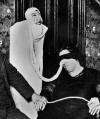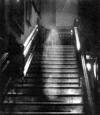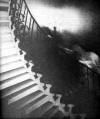|
Can Ghosts Be
Scientifically Verified?
by
Steve Johnson
For as long as there have been people, there have been ghost stories.
Indeed, the Ancient Greeks were fond of tales of ghosts and spirits and
the Far-Eastern cultures of China and the Indian subcontinent were replete
with spook-filled yarns. It is not difficult to imagine the earliest
humans huddling around their fires at night and telling good, scary
stories to the rest of the tribe.
Stories of ghosts and spirits are probably amongst the oldest of human
legends, yet even now, thousands and thousands of years after the dawn of
civilisation, there is not a jot of definite proof that ghosts exist.
Can the existence of ghosts be proven to a standard that will impress
today’s sceptical public?
The modern ghost hunter is armed with a plethora of technical devices
that, supposedly, can help him (or her, obviously, but our hypothetical
person will be a he from now on) detect the presence of possible
paranormal phenomena.
These range from simple, home-made devices like dowsing rods or plumb bobs
right up to expensive recording equipment and night vision cameras. In
between he may also have an arsenal of laser thermometers, electromagnetic
frequency (EMF) meter and audio recording equipment, such as dictaphones
or other digital sound recorders.
Yet, even with all of this hi-tech wizardry at their fingertips, there is
still not one concrete scrap of evidence to prove that there is some form
of existence after death. Sure, there are video recordings of mists, hazy
figures, strange shadows or audio recordings of eerie, almost
imperceptible voices or strange fluctuations in EMF fields, but none of
this stands up to close scrutiny and any number of alternative
explanations can be put forward to explain the phenomena captured.
The modern quest to prove the existence of ghosts began with the advent of
photography in the 19th century. So-called Spirit Photography
was big business and there are many examples littering the internet.
Almost all of them can be explained away as simple double exposures or
other darkroom trickery. Most of these were made in the days when one had
to sit still for a long time to record one’s image onto a photographic
plate. When more efficient cameras came along, spirit photography moved
along with it.
In
the early 20th century, séances became the trendy fad of the
day and many so-called mediums arose to fame and infamy. The great
illusionist, Harry Houdini, exposed many charlatans and others brought to
light the dodgy practices with which these ‘mediums’ duped a gullible
fee-paying public.
 One
such medium was Helen Duncan and she even spent time in prison, convicted
under the Witchcraft Act of 1735. Duncan was a medium whom, she alleged,
could produce spiritual ectoplasm. However, the ectoplasm was in actual
fact nothing more paranormal than muslin that she swallowed earlier and
regurgitated during the séance. She also used badly-made dolls in her act.
Duncan, to this day (she officially died of natural causes in 1956,
although it has been claimed that she died from an inflammation of the
bowels caused by the cloth she swallowed) has a large following and many
claim that she was a genuine materialisation medium. One
such medium was Helen Duncan and she even spent time in prison, convicted
under the Witchcraft Act of 1735. Duncan was a medium whom, she alleged,
could produce spiritual ectoplasm. However, the ectoplasm was in actual
fact nothing more paranormal than muslin that she swallowed earlier and
regurgitated during the séance. She also used badly-made dolls in her act.
Duncan, to this day (she officially died of natural causes in 1956,
although it has been claimed that she died from an inflammation of the
bowels caused by the cloth she swallowed) has a large following and many
claim that she was a genuine materialisation medium.
Anyway, back to ghost hunters and evidence:
There have been many photographs that purportedly depict ghosts. Some have
become very famous, like the Newby Church Ghost or the Brown Lady of
Raynham Hall, but are they photographs of genuine paranormal entities?
I’ll let you decide:








Other ways in which ghosts can manifest themselves on film (or more
accurately on a digital camera’s CCD) is through the phenomenon of Spirit
Orbs. Supporters claim that this is an early stage of a ghost
manifestation
 and
represents a build-up of energies in a spirit entity. The fact that orbs
only tend to appear on images taken with digital cameras only adds weight
to the argument that orbs are nothing more than specks of dust or water
droplets close to the camera lens that are illuminated when the flash goes and
represents a build-up of energies in a spirit entity. The fact that orbs
only tend to appear on images taken with digital cameras only adds weight
to the argument that orbs are nothing more than specks of dust or water
droplets close to the camera lens that are illuminated when the flash goes
 off.
Their proximity to the lens causes them to be out of focus, therefore
appearing as translucent, circular blobs of light. CCDs in digital cameras
are more sensitive than film and that's why specks of dust etc. show up
more in digital images. Other orbs taken by
both digital and film cameras could be attributed to the same and also to
lens flare, where a bright object in the frame reflects light back into
the lens. off.
Their proximity to the lens causes them to be out of focus, therefore
appearing as translucent, circular blobs of light. CCDs in digital cameras
are more sensitive than film and that's why specks of dust etc. show up
more in digital images. Other orbs taken by
both digital and film cameras could be attributed to the same and also to
lens flare, where a bright object in the frame reflects light back into
the lens.
Now we can move on to video evidence. With the rise in popularity of video
camcorders, the ghost hunter has been given access to a whole new way of
recording paranormal phenomena. These days, a good investigator will
possess a camcorder that has 0-lux capabilities, i.e. that can record in
complete darkness using an infra-red (IR) filter. Unfortunately, given the
ability to sneak up on ghosts in the dark, footage of spooks in their
natural habitat is strangely thin on the ground. After all, don’t ghosts
like the dark?
The truth is that most ghost images (including the ones displayed on this
page) are taken in broad daylight or in brightly-lit dwellings.
It
seems that most ghost videos these days come from CCTV cameras in places
like car parks! Below are some stills from alleged ghosts caught on video:






Obviously those images captured from video cannot be conclusive proof, but
there is no evidence that they were faked. There is also no evidence that
they weren’t either! However, one has been shown to be a natural
object that just looks like a ghost!
Another gadget that our erstwhile ghost hunter can use is the EMF meter.
Many companies now sell these devices as ‘Ghost Detectors’, but they were
originally produced to measure the EMF fields in workplaces with lots of
electrical equipment. Everything produces an electromagnetic field and it
is a widely-held theory that ghosts disrupt this field when they pass
through an area. A good investigator will walk through a supposedly
haunted area and get a good baseline reading of normal EM conditions. This
way, he will also be able to discount any electrical wiring or other
natural sources if there is a fluctuation during the investigation proper.
Of course, there has never been any evidence produced that a ghost has
disrupted the EM field. All that has been noted is a fluctuation in the
local field and such fluctuations can often be explained naturally rather
than supernaturally. Of course, though, this doesn’t mean that a ghost
wasn’t there, but it doesn’t prove that a ghost was there
either.
Finally, let’s move on to audio evidence. The phenomenon is known as
Electronic Voice Phenomenon (EVP) or Instrumental TransCommunication
(ITC), which is really a catch-all term that covers other forms of
supposed spirit communication through electrical equipment, such as
television sets.
The most common method for our ghost hunter to pick up EVPs is to use a
digital voice recorder (these are very inexpensive these days and can
store quite a lot of data), walk around a haunted location and ask
questions of the ghosts or spirits that are said to reside there. Most of
the time, no responses will be heard, but upon playing back the recording,
sometimes strange, eerie voices may be heard. Again, like the EMF
readings, most of these ‘voices’ can be explained away as natural sounds
from the environment, such as distant traffic, animals outside, the wind
etc., but sometimes definite, human voices can be heard, often replying
specifically to the questions asked. If any skulduggery can be eliminated
(that nobody in the next room spoke the words, say), this, in my view,
constitutes some of the best evidence for life after death!
So, after all of the technological advances made over the years, the best
evidence for ghosts comes not from what we see, but from what we hear.
Do
ghosts exist? I think so.
Do
you?
©
2005 Steve Johnson |